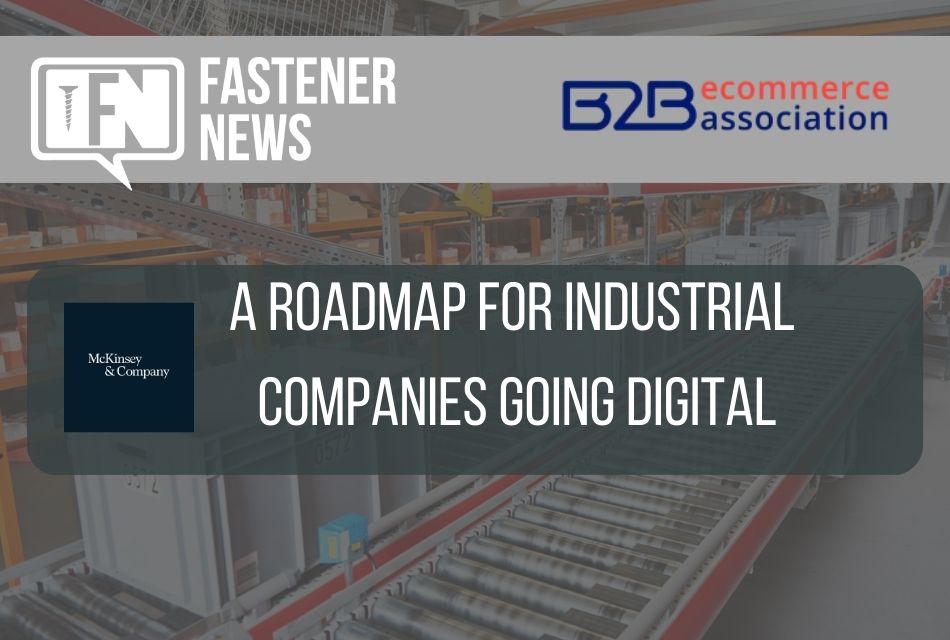Subtotal: $0.68
A Roadmap for Industrial Companies Going Digital

Editor’s note: This article from McKinsey explains in-depth how and why industry companies can embrace digital commerce and transformation. Creating strong digital B2B channels at industrial companies
The digital solutions common at many companies are new to most industrials. How can digitization take root in this complex industry?
Industrial companies realize that digitization is more than a buzzword and know that e-commerce, data analytics, and other solutions will transform every aspect of their businesses. Some have even set ambitious goals to reduce costs, increase revenues, or improve cash management through digital solutions, with many focusing on the digitization of sales and marketing as more end customers migrate online. This move is well considered, since research suggests that the number of B2B customers using digital self-service channels to research and evaluate products rose from 20 percent in 2016 to 30 percent in 2019 across industries. New or repeat orders made through digital B2B channels rose from 40 percent to 50 percent over the same period, representing trillions of dollars in value.
While industrials understand the importance of digitizing sales and marketing, few have embarked on extensive efforts in this area, and those that do often struggle with execution. After all, customers are accustomed to online B2C sales channels, which businesses have been perfecting for years, and expect industrials to deliver the same seamless experience across platforms. In most cases, however, they still fall short. Their deficiencies are becoming more obvious because COVID-19 has forced many companies to limit face-to-face interactions and increase online services, and that shift may become permanent. A recent McKinsey survey of B2B leaders showed that most respondents expected to be able to meet with customers in person by the start of 2022, but only 15 percent expected such meetings to be the norm going forward.
We recently analyzed more than 350 industrial companies to gauge their digital prowess—basically, the extent to which they were investing in digital tools and analytics—and determine if this had any impact on revenue growth or total returns to shareholders (TRS). The results revealed that a select group of companies stand out from the pack when it comes to driving performance improvement through digitization. The insights from this research, combined with our work with industrials, allowed us to identify some common success factors for digitization, including a clear focus on impact, employee buy-in, cross-functional collaboration, and a detailed implementation plan. This article reviews these concepts, as well as the benefits of a strong digital sales and marketing function. The next article in this series will provide more details about the framework for implementing digital initiatives at industrials.
Digitization and e-commerce are already helping B2B companies in some industries address pain points that detract from the customer experience and reduce profits (Exhibit 1). For instance, B2B companies have traditionally set prices on a cost-plus basis and made blanket increases each year across product categories without regard to demand. But those that apply digital tools and data sets can customize pricing for each product and customer group, or even test new pricing for those customers without pricing agreements.
Within sales and marketing, digital tools deliver three major benefits: an improved end-to-end customer journey, incremental sales opportunities, and increased sales-force efficiency. These benefits can translate into major improvements in revenue and TRS
In their lives as consumers, B2B buyers have become accustomed to researching products, placing orders, and tracking packages online. While industrials lag behind their B2C counterparts in digital capabilities, their customers still have the same expectations for top-notch online services.
When cultivating new customers, digitization can make outreach both simpler and less expensive. It will be particularly helpful with small accounts that many industrials have hesitated to pursue because of the low return on investment. Further, companies can use data and analytics to identify accounts that currently generate little revenue but have the potential for strong growth. Sales and marketing efforts that target such groups may produce better results than more widespread, unfocused campaigns.
Through automation, digital tools can create efficiencies in three important areas:
- Product, service, and order fulfillment. Digitization helps companies simplify their product offerings. By concentrating on the core products and solutions that matter for most of their customers, they can drive operational efficiencies. Digital tools can also help companies standardize lead times and make them more transparent; this will improve customer experience, since a lack of visibility into order tracking is a common pain point in the industrial sector.
- Commercial strategy and execution. Sales teams can accelerate deals by removing manual touchpoints and minimizing the time spent on administrative tasks, such as resolving issues after the sale (for example, invoice issues). With opportunities for both in-person interaction and online self-service, customers will also have more contact options, which could increase both loyalty and satisfaction.
- Customer service and transactions. Automation can streamline customer service and make it easier for people to interact with companies. For instance, chat bots, available around the clock, can answer many common questions for customers. Such features are standard at most B2C companies but have not yet gained traction within industrials.
By automating many processes and touchpoints, digitization will reduce the time that salespeople spend managing existing accounts, which now amounts to about half of their work. Automated solutions may be particularly appropriate for mundane but critical tasks, which can consume more time.
While the imperative to increase digitization is clear, the path forward can be complicated. Too often, industrials push for digital solutions because they see their competitors launching initiatives and fear missing out. In their haste, they may launch ambitious campaigns without appreciating the enormous resources—time, money, and staff—required. And some may incorrectly believe that a silver bullet, such as a capable implementation partner, will guarantee success when the reality is more complex.
Through our experience leading digital B2B transformations, as well as our survey of 350 industrial companies, we discovered that companies can escape common pitfalls by taking a more thoughtful approach. They can also win by forming partnerships with other businesses or vendors, such as systems integrators or website designers, to ensure that they have all the expertise required to deliver a complete solution. Here are the tactics we observed in the most successful companies.
It sounds simple: companies should focus on the areas that will have the most impact when implementing digital solutions. But a surprising number of B2B companies launch efforts that generate little operational or financial improvement. To avoid this trap, companies should begin with the clear articulation of a problem statement, such as “above average churn for the industry” or “substandard lead generation results in low customer acquisition despite high funnel conversion rates.” When seeking solutions, they should concentrate on changes that will tangibly improve the customer experience and eliminate critical pain points, such as by providing a seamless reorder process and easy order tracking, rather than striving for perfection in all areas. Likewise, companies should prioritize efficiency initiatives that will produce the greatest time savings.
Since industrials may serve thousands of customers, ultimately they must identify groups of customers with similar needs to create archetypes. For instance, they may find that certain small customers love hearing about new products, struggle to meet minimum order requirements, or experience frequent stock shortages. With these insights, companies can develop targeted marketing campaigns and solutions. Exhibit 2 matches pain points with digital solutions that can improve the end-to-end customer journey for a particular archetype.
Without buy-in from every level of the organization, digital transformations are likely to lose momentum and fail. Already, many companies have invested millions of dollars in new digital platforms but achieve mediocre results because their salespeople are not on board and stick to their old ways. To help their new strategies take root, CEOs should communicate the goals of the program and set clear financial and operational targets. Leaders should also determine how each function will contribute to these goals and assign specific responsibilities.
Companies must ensure that all functions and external partners are on the same page, since digital transformations will touch every aspect of their business. Consider the creation of an e-commerce platform. External partners may build the website, but manufacturing and logistics teams must also be involved because their systems will provide data about availability, lead times, and other relevant issues. Cross-functional collaboration is also essential for other tasks, such as linking online orders to sales and operations-planning processes and ensuring dynamic, consistent pricing across B2B channels.
In our analysis, we found that the digital leaders established cross-functional teams to avoid organizational silos and gave them the authority to make any necessary changes. They also helped channel partners and other external partners understand their new digital initiatives to build their support. Strong change management, guided by leaders, also helped because digital transformations have multiple moving parts, and a misstep in one area can derail the entire effort.
B2B companies can facilitate their digital transformations by concentrating on six essential elements:
- Creation of a business-led technology road map that describes the overall vision for the transformation, sets priorities for different business domains, assesses capabilities, discusses potential partnerships, and outlines implementation steps
- Talent development, including the upskilling required to deliver the technology road map
- Agile delivery methodologies, which will allow companies to build relevant solutions rapidly and improve them over time
- Creation of a modern-technology environment to support data-rich applications and frequent software upgrades
- Data management and enrichment, which will maximize the value of technology solutions
- Driving the adoption and scaling of the transformation efforts, which will involve building a new operating model and funding relevant initiatives
Companies should first identify key customer segments, determine what the customer journey looks like for each one, and create separate onboarding road maps. When determining which segments to target first, they should consider the ease of moving the customer journey online and the potential impact of this shift (for instance, the number of sales resources that would be freed up). Companies should also consider inherent risks, such as the possibility of losing a large account if a new e-commerce system has bugs.
A phased rollout, which only targets certain customer segments initially, will allow companies to learn from experience and make continuous enhancements to the platform as more customers are added. By the time the scale-out is complete, they will have fully optimized the e-commerce platforms that suit all major customer journeys.
Digital solutions can help every industrial company, but no single approach is right for all players. A small number of well-chosen initiatives that focus on customer needs and have clear targets is likely to produce better results than a wide-ranging program with amorphous goals that are not linked to customer impact. While it may be tempting to act rapidly, out of fear of being left behind, careful planning and a solid implementation strategy will carry the day.
ABOUT THE AUTHOR(S)
Chris Angevine is a partner in McKinsey’s Atlanta office; Ruhan Meyer is a consultant in the Seattle office; and Jannick Thomsen is a partner in the New York office, where Rodney Zemmel is a senior partner.
Digital Transformation, Fastener News, Industrial Distribution, digital














Leave a Reply